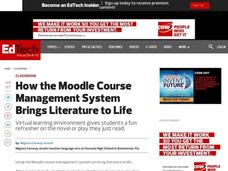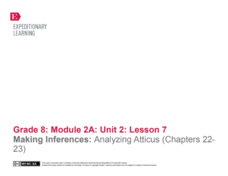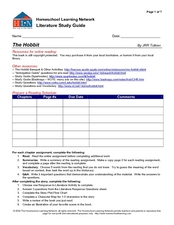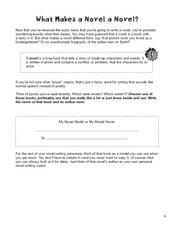Novelinks
Wuthering Heights: Concept/Vocabulary Analysis
New to using Bronte's Wuthering Heights in the classroom; check out this overview of themes, characters, settings, and project suggestions.
Curated OER
A Novel Idea
Learners use Moodle to participate in a chat session to complete a character analysis for a novel they've studied. In this novel analysis and technology lesson, students are assigned a character from a specific chapter and use Moodle to...
Curated OER
The Outsiders Character Chart: Dally
In this The Outsiders character chart, students will evaluate Dally from several points of view. Students will evaluate how Dally looks, what he says, how he acts, what other characters think about him, and what the reader thinks about...
K12 Reader
If
Rudyard Kipling's advice to his son in the poem "If" is a resounding message that echoes through generations. After reading the famous poem, middle schoolers work on analyzing specific lines, completing activities based on unfamiliar...
Star Wars in the Classroom
"Shakespeare and Star Wars": Lesson Plan Day 2
Ta DUM, ta DUM, ta DUM, ta DUM, ta DUM. The force will be strong in the hearts of your young Jedi as they use their lightsabers to strike the accentted syllables in lines from Ian Doescher's William Shakespeare's Star Wars: Verily, A New...
Curated OER
Breaking Down Books
Learners practice their reading comprehension by analyzing and discussing books with their classmates. They record their responses to comprehension, evaluation, and interpretation questions provided on a worksheet that is referenced but...
Curated OER
Outsiders Unit Plan
Students complete novel analysis activities for the The Outsiders. For this novel analysis lesson, students complete three weeks of lessons that help them analyze the text and character education lessons within the novel.
Student Achievement Partners
Eleven
Turning 11 comes with a range of emotions. Explore those emotions by reading the short story "Eleven" by Sandra Cisneros. Readers analyze the main character's reactions to the events of her day. Then, they write an essay describing what...
EngageNY
Characters and Consequences
Scholars consider how dialogue reveals aspects of a play's characters as they read Shakespeare's A Midsummer Night's Dream and complete a written conversation note-catcher. Additionally, pupils participate in an I Have/Who Has jigsaw...
EngageNY
Analyzing the Resolution of the Play: World Café Discussion
It's time to get active! Scholars participate in a World Café protocol to promote discussion and leadership. They leave their seats and move from group to group to discuss critical questions related to their read-aloud of Shakespeare's A...
EngageNY
Launching the Text: Building Background Knowledge on Louie Zamperini and World War II (Preface, Pages 3–6)
Scholars participate in a gallery walk to examine photographs related to WWII and record thoughts about the pictures in note catchers. At the end of the gallery walk, pupils share their observations before participating in a discussion...
EngageNY
Close Reading: Focusing on Taking a Stand (Chapter 2 cont.)
Scholars complete a close read of To Kill a Mockingbird and determine why characters take a stand. They use text-dependent questions and Note-catchers to help guide their thinking. Readers review the Taking a Stand Anchor chart and...
EngageNY
Text to Film Comparison: Taking a Stand at the Jailhouse (Chapters 14-15)
Readers look closely at Scout in chapter 15 of To Kill A Mockingbird. Learners use turn and talk and Analyzing Scout's and the Reader's Perspectives Note-catcher to compare their perspectives to Scout's. They then make a comparison to...
EngageNY
Making Inferences: Analyzing Atticus (Chapters 22- 23)
What's the verdict? Scholars look closely at the reactions of various characters in To Kill A Mockingbird in the aftermath of the verdict. They circulate the room, responding to a variety of probing questions. Pupils finalize their...
EngageNY
Close Reading: Fishbowl Comparing Atticus and Mr. Gilmer (Chapters 17-19)
Class members participate in two circle group discussions to compare Atticus and Mr. Gilmer in chapters 17-19 of To Kill a Mockingbird. They use a note-catcher to guide their thinking. For homework, readers begin looking at chapters 20-21.
EngageNY
Characters’ Decisions: The Flow of Consequences in Midsummer
Class members meet in their drama circles and share their thoughts on why it might be necessary for the audience to know something the characters don't. They read Act 3 Scene 2 of A Midsummer Night's Dream and complete consequence flow...
EngageNY
Performance Task: Readers Theater Performance
It's show time! Scholars finalize their learning by performing their Reader's Theater script of To Kill A Mockingbird. As groups of actors perform, the remaining pupils give feedback using a rubric. After all groups finish, each person...
EngageNY
Leaving the Play: All’s Well That Ends Well
How does Shakespeare develop the theme of control in A Midsummer Night's Dream? Using the resource, scholars analyze the theme of parental control in the play and the Greek myth "Pyramus and Thisbe." Next, they talk to partners to...
EngageNY
Launching the Performance Task: Prompt, Characters, Groups
Scholars unpack the word confession as they prepare to write confessionals based on characters from Shakespeare's A Midsummer Night's Dream. Next, they read their narratives to a small group of peers as part of a final performance task.
National Endowment for the Humanities
Symbolism in Lord of the Flies
Readers of Lord of the Flies examine the four main symbols William Golding develops in his novel: the island, the conch, the Lord of the Flies effigy, and fire. Partners select one of the major symbols and create an image by adding words...
Curated OER
Using Inspiration Software to Explore Characters In Stories
Students identify characters, their qualities, and examples of their qualities and use Inspiration to organize them in a clear and understandable format. After a lecture/demo, students use the program on the next story by themselves.
Curated OER
Literature Study Guide - The Hobbit
With several online resources for J.R.R. Tolkien's The Hobbit, as well as many reading and literary analysis activities, this novel study guide is a great way to keep your young readers organized during a book report. The guide includes...
Curated OER
What Makes a Novel a Novel?
As your authors prepare to write a hypothetical novel, they need all the inspiration they can find! Using a book they have already read (and enjoyed), learners complete a literary analysis by filling in eight short-answer questions....
Curated OER
Cyrano De Bergerac: Understanding Drama Through Characterization and Dialogue
Students explore three major dramatic concepts using Cyrano de Bergerac by Edmond Rostand. In this dramatic concepts lesson, students research the concepts of universal theme, characterization, and dialogue using the given text. Students...
Other popular searches
- Character Analysis Essay
- Theatre Character Analysis
- Character Sketch Outlines
- Writing a Character Analysis
- Character Sketch Lesson Plan
- Character Analysis Seedfolks
- Character Study Lesson Plans
- Character Sketch Examples
- Character Analysis Worksheets
- Character Analysis Writing
- Descriptive Character Sketch
- Character Analysis Lessons

























